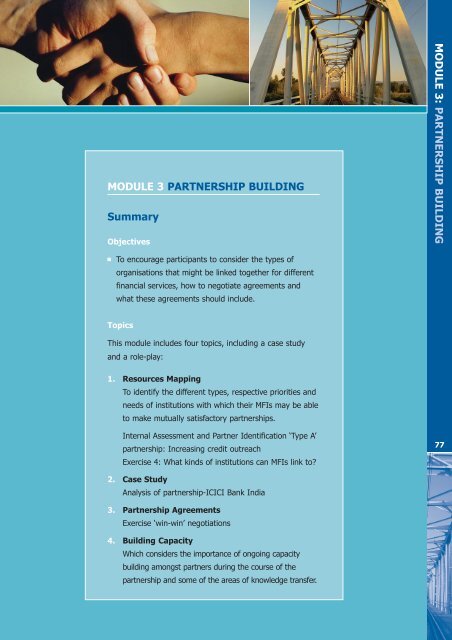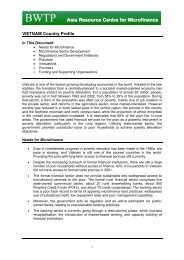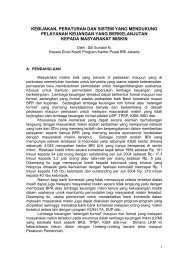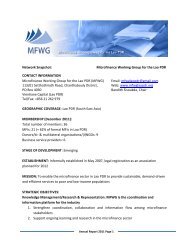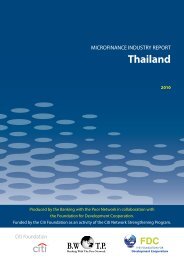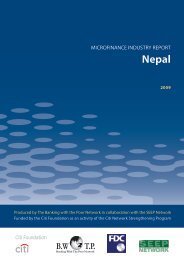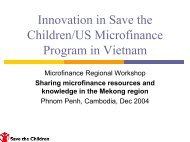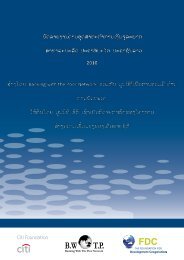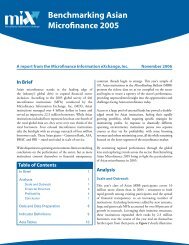MODULE 3 PARTNERSHIP BUILDING Summary
MODULE 3 PARTNERSHIP BUILDING Summary
MODULE 3 PARTNERSHIP BUILDING Summary
Create successful ePaper yourself
Turn your PDF publications into a flip-book with our unique Google optimized e-Paper software.
<strong>MODULE</strong> 3 <strong>PARTNERSHIP</strong> <strong>BUILDING</strong><br />
<strong>Summary</strong><br />
Objectives<br />
<strong>MODULE</strong> 3: <strong>PARTNERSHIP</strong> <strong>BUILDING</strong><br />
To encourage participants to consider the types of<br />
organisations that might be linked together for different<br />
financial services, how to negotiate agreements and<br />
what these agreements should include.<br />
Topics<br />
This module includes four topics, including a case study<br />
and a role-play:<br />
1. Resources Mapping<br />
To identify the different types, respective priorities and<br />
needs of institutions with which their MFIs may be able<br />
to make mutually satisfactory partnerships.<br />
Internal Assessment and Partner Identification ‘Type A’<br />
partnership: Increasing credit outreach<br />
Exercise 4: What kinds of institutions can MFIs link to<br />
77<br />
2. Case Study<br />
Analysis of partnership-ICICI Bank India<br />
3. Partnership Agreements<br />
Exercise ‘win-win’ negotiations<br />
4. Building Capacity<br />
Which considers the importance of ongoing capacity<br />
building amongst partners during the course of the<br />
partnership and some of the areas of knowledge transfer.
1234567890123456789<br />
1234567890123456789<br />
1234567890123456789<br />
1234567890123456789<br />
<strong>MODULE</strong> 3: <strong>PARTNERSHIP</strong> <strong>BUILDING</strong><br />
Module 3: Partnership Building<br />
1234567890123456789<br />
1234567890123456789<br />
Estimated duration<br />
1234567890123456789<br />
1234567890123456789<br />
1234567890123456789<br />
The time required for this<br />
1234567890123456789<br />
1234567890123456789<br />
module will be greatly<br />
dependent on time taken for<br />
1234567890123456789<br />
1234567890123456789<br />
the Case Study 1234567890123456789<br />
and role-plays<br />
1234567890123456789<br />
contained within. However,<br />
1234567890123456789<br />
allow approximately one 1234567890123456789 full<br />
day of the workshop.<br />
1234567890123456789<br />
1234567890123456789<br />
Technique<br />
1234567890123456789<br />
1234567890123456789<br />
1234567890123456789<br />
Presentation & Group<br />
1234567890123456789<br />
discussion<br />
Slide 1 - Module 3: Partnership Building<br />
Resources needed<br />
1234567890123456789<br />
1234567890123456789<br />
1234567890123456789<br />
Butcher’s paper and<br />
1234567890123456789<br />
1234567890123456789<br />
markers for participants<br />
Flipchart paper<br />
1234567890123456789<br />
1234567890123456789<br />
1234567890123456789<br />
Digital projector<br />
1234567890123456789<br />
Module 3 1234567890123456789<br />
presentation<br />
1234567890123456789<br />
Module 3 handouts.<br />
Slides<br />
1234567890123456789<br />
1234567890123456789<br />
1234567890123456789<br />
1234567890123456789<br />
1-3<br />
Objective<br />
To encourage participants to consider the types of organisations that might be linked<br />
together for different financial services, how to negotiate agreements and what<br />
these agreements should include.<br />
78<br />
Slide 2 - Module 3: Partnership Building<br />
CAPACITY <strong>BUILDING</strong> FOR <strong>PARTNERSHIP</strong>S IN MICROFINANCE TRAINER'S MANUAL
Introduction to the Topic<br />
Partnership building represents the stage of the partnering process whereby partners<br />
identify what they can/will specifically contribute to the partnership, make<br />
agreements based on this and create a vision for the partnership. Capacity is built<br />
based on recognition of each partner’s respective strengths and weaknesses.<br />
Topics<br />
This module includes four<br />
topics, including a case study<br />
and role-play:<br />
<strong>MODULE</strong> 3: <strong>PARTNERSHIP</strong> <strong>BUILDING</strong><br />
1. Resources Mapping<br />
To identify the different<br />
types, respective priorities<br />
and needs of institutions<br />
with which their MFIs may<br />
be able to make mutually<br />
satisfactory partnerships.<br />
Internal Assessment and<br />
Slide 3 - The Partnering Process<br />
Partner Identification ‘Type A’ partnership: Increasing credit outreach<br />
Exercise 4: What kinds of institutions can MFIs link to<br />
2. Case Study<br />
Analysis of ICICI Bank India - MFI Partnerships.<br />
79<br />
3. Partnership Agreements<br />
‘Win-win’ negotiation exercise<br />
4. Building Capacity<br />
Which considers the importance of ongoing capacity building amongst partners<br />
during the course of the partnership and some of the areas of knowledge transfer.<br />
THE FOUNDATION FOR DEVELOPMENT COOPERATION & CITI FOUNDATION
1234567890123456789<br />
1234567890123456789<br />
1234567890123456789<br />
1234567890123456789<br />
<strong>MODULE</strong> 3: <strong>PARTNERSHIP</strong> <strong>BUILDING</strong><br />
TOPIC 1<br />
Resource Mapping<br />
Slide 4 - Topic 1 Resource Mapping<br />
1234567890123456789<br />
1234567890123456789<br />
Estimated duration<br />
1234567890123456789<br />
1234567890123456789<br />
1234567890123456789<br />
60 minutes<br />
1234567890123456789<br />
1234567890123456789<br />
Technique<br />
1234567890123456789<br />
1234567890123456789<br />
1234567890123456789<br />
Short introductory talk<br />
1234567890123456789<br />
Participatory exercise:<br />
1234567890123456789<br />
Part 1234567890123456789<br />
4 of a set of 4<br />
1234567890123456789<br />
exercises - 1234567890123456789<br />
Investigating<br />
qualities 1234567890123456789<br />
formal financial<br />
institutions 1234567890123456789<br />
are looking for<br />
1234567890123456789<br />
in 1234567890123456789<br />
a partner and to identify<br />
possible institutional<br />
1234567890123456789<br />
sources of finance.<br />
1234567890123456789<br />
1234567890123456789<br />
Resources needed<br />
1234567890123456789<br />
1234567890123456789<br />
1234567890123456789<br />
Handout 3.1 What do formal<br />
1234567890123456789<br />
financial institutions want<br />
Slides<br />
1234567890123456789<br />
1234567890123456789<br />
4-8<br />
Objective<br />
To enable participants to identify the different types of institutions with which their<br />
MFIs may be able to make mutually satisfactory partnerships, and to identify their<br />
respective priorities and needs in order to negotiate relationships that satisfy all parties.<br />
Questions to Address<br />
80<br />
What kind of resources can a<br />
partner make available<br />
What kinds of institutions can<br />
MFIs link to<br />
What do formal financial<br />
institutions want<br />
Slide 5 - 1. Resource Mapping<br />
CAPACITY <strong>BUILDING</strong> FOR <strong>PARTNERSHIP</strong>S IN MICROFINANCE TRAINER'S MANUAL
TOPIC 1<br />
Notes<br />
Resource Mapping<br />
i) The handout should be changed if necessary to reflect the types of formal<br />
financial institutions that are likely to be involved in MFI partnerships in<br />
participants’ regions. If international development finance institutions, such as<br />
IFC, the World Bank, ADB, EBRD, or KfW, are active in MFI partnerships, it may<br />
be appropriate to adapt the case study to fit one of them or possibly to invite a<br />
staff member of the institution to share her or his experiences with the group.<br />
Similarly, the case could be altered to cover a major bank that is involved in<br />
partnerships with MFIs, such as Citibank, ABN AMRO, ANZ Bank, or other large<br />
local commercial and public sector banks. It is important, however, that all the<br />
major types of institutions are covered.<br />
<strong>MODULE</strong> 3: <strong>PARTNERSHIP</strong> <strong>BUILDING</strong><br />
Mapping Resources<br />
The results of the internal<br />
assessment, as well as revealing<br />
limitations, should produce an<br />
exhaustive list of the knowledge<br />
and capabilities of the<br />
organisation.<br />
In the context of partnership<br />
negotiations, these form the<br />
basis of what an MFI or bank<br />
may offer to the partner. These Slide 6 - What Can We Bring to the PartnershipAdapted<br />
may be both readily obvious, from: Tennyson.R (2003) The Partnering Toolbook,<br />
ILBF/GAIN<br />
such as in finance or access to<br />
clientele, but may uncover other benefits, both tangible and intangible, that may be<br />
attractive to potential partners. Organisations should not necessarily try to predict<br />
what may or not be attractive to potential partners, and should place all that is<br />
practicable on the table when instigating or negotiating partnerships.<br />
81<br />
THE FOUNDATION FOR DEVELOPMENT COOPERATION & CITI FOUNDATION


